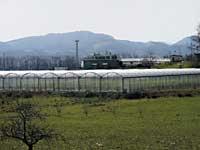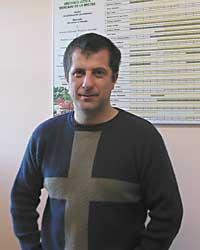Agrovillages, agriculture within reach of all?

Many times it is heard that there is little land, which hinders the development of the agrovillage. But no! Euskal Herria is small and here we live many people, but there is no small land.
What happens is that most of the land there is is private. In Gipuzkoa and Bizkaia, for example, and especially in Gipuzkoa, there is no public soil. What is there is private and worth a lot.
On the other hand, some agricultural lands are losing due to their use for other needs (industry, housing construction, etc. ). Something needs to be done to protect those soils good for agriculture and encourage activity. One way to achieve this is the example of agrogroups. In addition to the protection of the land, through a project these lands are conditioned, as is done in the industry, through works of urbanization: water, electricity, roads. Agrovillages are therefore models or ideas promoted by municipalities.
The problem is that land is public, so if you decide it is for any other activity, agriculture does not win as much as other sectors. Consequently, there is always danger of extinction of these lands.
By Gipuzkoa
The idea of agrovillages arose in Euskal Herria in 1992, in Oiartzun, and there are currently five agrovillages in progress: San Marcos (Renteria-San Sebastián), Asteasu, Arragua (Oiartzun), Astigarraga and Lezo, among others, are several roads (Bergara, Irun...). All of them are public property estates, divided into plots between 4,000 and 10,000 m 2. They have common general infrastructures (light, water, access, closures) and are dedicated to the cultivation of vegetables, plants or cut flowers.
Two of these five agrogroups have cogeneration plants that produce electricity and heat simultaneously from a fuel, usually natural gas.

The agrovillage of San Marcos, for example, is located in the vicinity of the urban solid waste dump of San Sebastian, which allows to use as heating the water used by the engine of the biogas plant of the landfill, from is extracted. This is because the combustion plant generates methane (biogas), which after its mixture with natural gas generates electricity.
Something similar happens in Arragua de Oiartzun. There natural gas is also burned and electricity is generated.
In these areas, vegetables and plants are produced, mainly tomatoes. All these productions can be made in soil, pot or hydroponic form, both in greenhouse and outside. Hydroponic cultivation is really a subtle word. It is a crop in which plants do not grow on land, but this function is performed by an artificial substrate made of clay. The bags or sacks of these treated clays are placed on the ground and the plant arrives with irrigation. The greenhouse, for its part, meets the climatic needs of plants.
Pesticides are not used in these systems, so this is a clean production, that is, without chemical residues. In addition, the plant process is controlled from the beginning to the end by a computer system.
Agroaldea vs Industrialdea
Undoubtedly, the agro-village arises in the shade of the polygon. However, institutions are much less committed to agro-villages. Something normal. Much more land is needed to get much less jobs.

They differ greatly from the industrial estates, on the one hand the economic and on the other the site, since for the realization of agrovillages, in general, land is not selected, they are located on the margins and in many cases are filled, since they are undesirable grounds for any other purpose. In addition to all this, producers never take ownership of these lands. In industrial estates, for their part, they have a period of between 10 and 20 years to progressively acquire the plot that has initially been leased. In agrovillages, however, the land cannot be bought. The rents are very cheap, about 180 euros per year.
Agroaldea is a long-term bet. And the project aims to recover and produce public land or at least give that opportunity to whoever wants to produce it. The Provincial Council of Gipuzkoa itself sees the future along this path, especially in the horticulture sector.
Juan Kruz Alberdi: “In agrovillages a lot of land is needed and in Gipuzkoa there is very little land available and available for agriculture”
What is Behemendi?
Behemendi is a rural development association of Donostialdea. Its function, of course, is to promote rural development. As for Gipuzkoa, there are also rural development associations in Tolosaldea, Urola, Bajo Deba, Alto Deba and Goierri. And they spread throughout the Autonomous Community of the Basque Country.
What role does the association play in the promotion of the agrovillage?

Our goal as a Behemendi technician is to launch agrovillages. There are no other entities doing this work. We mainly look for and condition land. Also part of Behemendi are all the municipalities of the valley, as well as associations and unions of baserritarras of the valley. Of course, they work together with the Council.
How do you see from your association the future of agrogroups?
From a positive point of view, no one questions the proper functioning of the horticultural sector. At present it is probably the sector that best results is giving in Euskal Herria. Vegetable consumption has increased considerably throughout the decade.
In addition, the activity that least soil needs is horticulture. Therefore, for this use we will have to look for land, if not another. In fact, in agrovillages the only activity that can be developed is horticulture, since grazing and livestock care need a lot of land. To make an idea it takes about 10-100 times more surface.
Looking ahead, however, it can be said that the future of agrogroups is quite difficult. The situation in the sector is very black. In short, the situation of the agrovillages is only a consequence of the situation of the agricultural sector.
In Gipuzkoa, for example, there are no young people who want to continue in the sector and the urban pressure is so great that it is very difficult to produce. Both orchard products and anything else. It takes a lot of land and in Gipuzkoa, due to its physical characteristics, there is very little availability and availability of soil.





